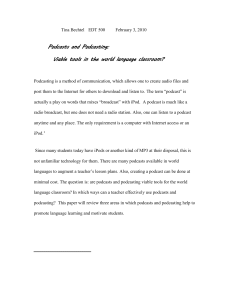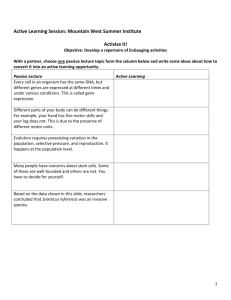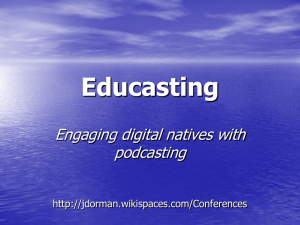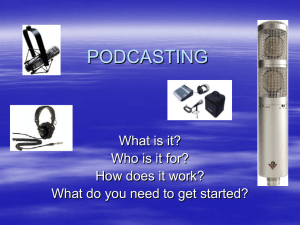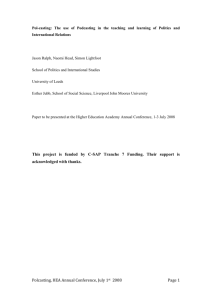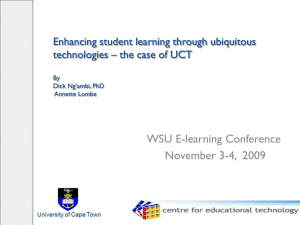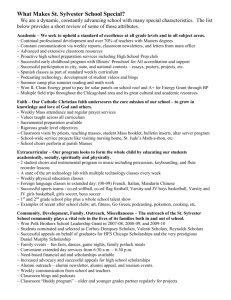conf_P_1057_Mclo _Chan ACEC final 2008
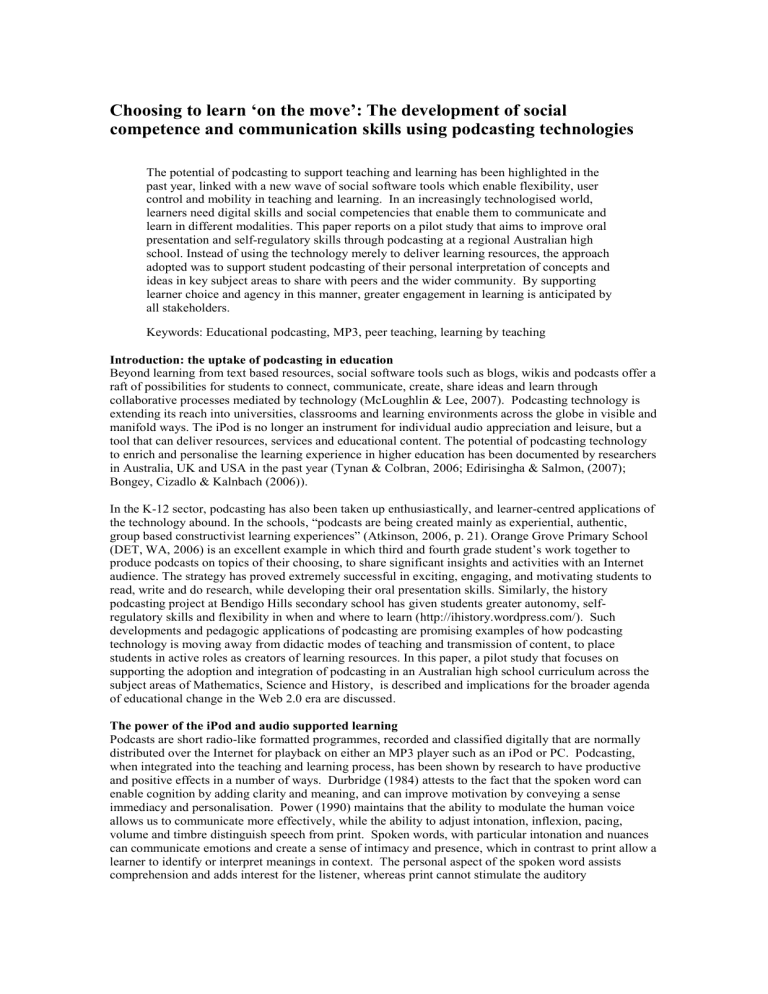
Choosing to learn ‘on the move’: The development of social competence and communication skills using podcasting technologies
The potential of podcasting to support teaching and learning has been highlighted in the past year, linked with a new wave of social software tools which enable flexibility, user control and mobility in teaching and learning. In an increasingly technologised world, learners need digital skills and social competencies that enable them to communicate and learn in different modalities. This paper reports on a pilot study that aims to improve oral presentation and self-regulatory skills through podcasting at a regional Australian high school. Instead of using the technology merely to deliver learning resources, the approach adopted was to support student podcasting of their personal interpretation of concepts and ideas in key subject areas to share with peers and the wider community. By supporting learner choice and agency in this manner, greater engagement in learning is anticipated by all stakeholders.
Keywords: Educational podcasting, MP3, peer teaching, learning by teaching
Introduction: the uptake of podcasting in education
Beyond learning from text based resources, social software tools such as blogs, wikis and podcasts offer a raft of possibilities for students to connect, communicate, create, share ideas and learn through collaborative processes mediated by technology (McLoughlin & Lee, 2007). Podcasting technology is extending its reach into universities, classrooms and learning environments across the globe in visible and manifold ways. The iPod is no longer an instrument for individual audio appreciation and leisure, but a tool that can deliver resources, services and educational content. The potential of podcasting technology to enrich and personalise the learning experience in higher education has been documented by researchers in Australia, UK and USA in the past year (Tynan & Colbran, 2006; Edirisingha & Salmon, (2007);
Bongey, Cizadlo & Kalnbach (2006)).
In the K-12 sector, podcasting has also been taken up enthusiastically, and learner-centred applications of the technology abound. In the schools, “podcasts are being created mainly as experiential, authentic, group based constructivist learning experiences” (Atkinson, 2006, p. 21). Orange Grove Primary School
(DET, WA, 2006) is an excellent example in which third and fourth grade student’s work together to produce podcasts on topics of their choosing, to share significant insights and activities with an Internet audience. The strategy has proved extremely successful in exciting, engaging, and motivating students to read, write and do research, while developing their oral presentation skills. Similarly, the history podcasting project at Bendigo Hills secondary school has given students greater autonomy, selfregulatory skills and flexibility in when and where to learn (http://ihistory.wordpress.com/). Such developments and pedagogic applications of podcasting are promising examples of how podcasting technology is moving away from didactic modes of teaching and transmission of content, to place students in active roles as creators of learning resources. In this paper, a pilot study that focuses on supporting the adoption and integration of podcasting in an Australian high school curriculum across the subject areas of Mathematics, Science and History, is described and implications for the broader agenda of educational change in the Web 2.0 era are discussed.
The power of the iPod and audio supported learning
Podcasts are short radio-like formatted programmes, recorded and classified digitally that are normally distributed over the Internet for playback on either an MP3 player such as an iPod or PC. Podcasting, when integrated into the teaching and learning process, has been shown by research to have productive and positive effects in a number of ways. Durbridge (1984) attests to the fact that the spoken word can enable cognition by adding clarity and meaning, and can improve motivation by conveying a sense immediacy and personalisation. Power (1990) maintains that the ability to modulate the human voice allows us to communicate more effectively, while the ability to adjust intonation, inflexion, pacing, volume and timbre distinguish speech from print. Spoken words, with particular intonation and nuances can communicate emotions and create a sense of intimacy and presence, which in contrast to print allow a learner to identify or interpret meanings in context. The personal aspect of the spoken word assists comprehension and adds interest for the listener, whereas print cannot stimulate the auditory
senses”(para. 2). Leach, Lewin, & Pearson, 2006 argue that although podcasting is a form of broadcasting, it can be integrated with other technologies such as discussion boards and email to facilitate two-way interaction among peers, teachers and learners.
Across the globe, tech-savvy students have already adopted mobile listening devices to plug into their favourite music, so it would seem obvious that educators should work to harness the popularity of this technology that has already been adopted by a broad age range (McLoughlin & Lee, 2007). Young people’s use of digital media outside of school is often in stark contrast to what happens in school. Until quite recently, much of what has happened in school has remained untouched by technology, and there is evidence of another digital divide, ie the gap between the digital culture of the school and the home.
Many school children live technology saturated childhoods, and enjoy access to a range of technologies enabled by broadband connections, while consuming and participating in a diverse range of social networking experiences, and going beyond information retrieval. Not surprisingly, schools in Australia and around the world are gradually beginning to explore the potential of social software tools and to integrate them into teaching and learning (McLoughlin, Lee & Chan, 2007).
There have been numerous studies attesting to the success of podcasting to support learning. For example, it has been noted that students learn oral presentation skills more effectively through experiential learning involving trial and error rather than through teaching of an explicit rhetorical model
(Haber & Lingard, 2001). The active creation of a narrative, and the performance of this to an audience is a learning task that students find both engaging and demanding. Chan & Lee (2005) found that students are more willing to listen to short 5-minute podcasts as opposed to long audio programmes on academic content. Clark & Walsh, (2004) state that “It should come as no surprise that people do like hearing others speak to them. There is still a strong social need for teachers, trainers and lecturers to stand in front of people and talk at them.”
The project described in this paper focuses on developing a pedagogical podcasting model, integrated into the school curriculum whereby students develop communication skills by recording their interpretations and ideas in class concepts, communicating these to peers and eliciting feedback on. The specific research questions are as follows:
1.
What pedagogical approaches can support the integration of podcasting into the teaching of mathematics, science and history to support student learning in an Australian high school?
2.
How can podcasting be used to enable students to take an active role in learning by extending the choices they are given to communicate and learn with peers?
Context of the study
The geographical area where the school is located is a hub of agribusiness, agriculture, agronomy, animal production, equine management, horticulture, irrigation and food processing. Many of the students in this regional school are first-generation learners studying up to Year 10/12. Feeder primary schools come from as far as 60 kilometres away. Many students travel to school by bus, taking up to 50 minutes in travelling time each way. The school has already approved the use of MP3 players for these students, so that they can access sound files during travel time. A survey of teachers at the school revealed the need for additional skills in digital technologies and applications, while it was recognised that regional and rural students would benefit by being able to listen in to podcasts of academic material during
“downtime” or travel time. The project aims address these issues in context and to improve the learning outcomes of these regional students across a range of key learning areas by using ICT in innovative and creative ways that are both relevant and appealing, while being fully integrated with the school curriculum.
A further focus of the project is to capitalise on the availability and use of iPods among students in order to develop podcasting methods to improve oral presentation skills in a number of subject areas including
Maths, Science and History. Many of these students aspire to progress to tertiary education and enter a nearby regional university after Year 12 completion, and will need high level communicative skills. A further rationale for the study was therefore to develop generic (oral) skills for university entrance as it has been noted that many first year students lack the oral presentation and communication skills to succeed at university (Feldman, 2005). Furthermore, the project was intended to appeal to students in
fringe regional and rural areas who spend a lot of time travelling on school buses daily, often “pluggedin” to a set of earphones for most of the journey. By tuning into short podcasts created by their own classmates explaining Science and Maths concepts or relating an historical experience, and responding with a talk-back podcast by them to provide feedback was considered a strategic way to increase interest and motivation, while improving digital literacy and communication skills.
Design based research applied to the study
Beyond empowering students to create and share audio files, the project seeks to develop pedagogical models that will inform the design of learning activities in mathematics, science and history and to promote self-regulatory skills through learner choice of location, space, method of production and reception of audio files. In addition the project allows students to podcast in their own communicative style to articulate their understanding of concepts and topics brought up in class and to share these interpretations and reflections with peers either through narrative, role play, interview format or discussion. Research has indicated that learning needs are often drivers for learning, and that for learning to be optimally effective it needs to relate to learner interests, goals and self-regulatory processes (Dron,
2007).Teachers scaffold the production of scripts for the podcast episodes, and ensure that students are working in collaborative teams and aware of ethical conduct.
The study uses a qualitative methodology, specifically design based research, to investigate the impact of podcasting technology on student learning. Design experimentation is an inter-disciplinary approach that acknowledges the applied nature of educational research. In this approach, researchers work in partnership with educators seek to refine theories of learning by designing, studying, and refining theorybased innovations in realistic classroom environments (Reeves, Herrington & Oliver, 2004). Figure 1
Design Based Research Stages for Podcasting Project
Analysis of problems by researchers and practitioners
Development of solutions with a theoretical framework
Evaluation and testing of pedagogical solutions in practice
Documentation & reflection to produce “Design
Principles” for podcasting
Refinement of Issues, Solutions and Podcasting Methods
Adapted from Reeves, Herrington & Oliver (2004)
The research is proceeding in stages as follows:
Stage 1: Analysis of practical problems by researchers and teachers
The focus of this stage is on students’ needs for digital and communication skills and with gaining teacher perspectives on how to integrate technology into the classroom in order to improve student learning outcomes in a number of KLA’s
Stage 2: Development of solutions within a theoretical framework
The researchers work in partnership with the school community to introduce and integrate podcasting into the curriculum and to enhance teacher pedagogies. The school has already approved the use of MP3 players for students, so that students are already attuned to the notion of listening during travel time.
Teachers at the school have reported that they need additional skills in digital technologies and applications, while students have supported the initiative to create podcasts of academic material during
“downtime” or travel time to share with peers.
Stage 3: Evaluation and testing of solutions in practice
At this stage, teachers introduce students to scripting episodes for podcasting and enable them to express their understanding of subject matter in science, history and mathematics.
Stage 4: Documentation and reflection to produce design principles
The impact of the podcasting experience will be assessed by interviewing students and teachers.
Following the feedback received, preliminary design principles will be developed to integrate podcasting experiences into student learning.
Methodology: Engaging students in podcast creation
In the project, where the context is the high school curriculum, the achievement of the intended learning outcomes will occur through student planning, recording and creation of podcasts, in the form of short radio talk-backs style narrative episodes available to other students. The High School is now evolving as an active podcasting “community of practice” –with teachers working with students in preparing podcasts of additional information for their weekly school newsletter. A group of students have already been trained in podcast recording techniques. An international exchange of podcasts with a Japanese high school is also underway for those taking Japanese in Year 12.
The pilot project was launched in the school in late 2007 with two groups of students being taught podcasting. The table shows the breakdown.
Table 1: Breakdown of Training Groups
Group 1 Group 2
Selection of Students
Number of Sessions
Number of Participants
Number Completed Training
Percentage of Successful Completion
Years 8 and 9
6 x 2 hours each
18
12
66.6%
Years 7 to 9
8 x 2 hours each
20
12
60.0%
The preparatory session consisted of students engaging in the following skills: script writing and editing, audio presentation, audio recording and editing, mechanisms of publishing and distribution of podcasts, evaluation of good podcasts and an explanation into the difference between software available on the
Apple Macintosh and Microsoft Windows platforms. The training team consisted of one of the authors of this paper and a team of 2 female and 2 male undergraduate university students acting as “facilitators”.
Project progress
Students who completed the training went on to create a team-produced podcast, while those who did not create a podcast directly were involved in other tasks ( for example editing) and in the podcast review process. Besides this, the facilitators also saw the need to have modules of work prepared for the integration of podcasting into teaching and learning. This has required close collaboration with teachers.
In addition, two guidebooks have been prepared with modules geared for teaching podcasting skills to high school students. An Acceptable Use Policy also surfaced as one of the requirements that was needed for participants to understand what can or cannot be done.
The school executive board in consultation with school staff members has also overturned a decision to ban portable MP3 players in the school. This indicated that the school executives and teaching staff are very receptive to the socio-cognitive changes with the widespread adoption of MP3 players and podcasting technology usage among students. These players are now used out of class situations, during recess and lunch, with students listening to subject content produced by peers and teachers.
Project progress
Following the initial training, podcasting activities are being integrated into History, Mathematics and
Science and resources are being prepared in consulation with subject teachers and students. Varied formats are being explored and trialled including student-to-student conversations about subject material. reflections by individual students, interviews with experts and community members and enrichment materials co-produced by teachers and students. Students can now learn and access resources in out-ofschool settings, and this empowerment and choice is proving to be both popular and motivating force in among the student community.
The success of this pilot is also demonstrated by these encouraging words, published in the school newsletter.
Ms. X’s Year 11 Modern History has completed researching podcasts for their Decolonisation in
Indochina oral assessment tasks. The teacher was chuffed with the balance of historical detail and creativity evident in the recordings. As well as the podcasts, the class then actively and responsibly engaged in peer assessment of each other’s work. In the follow-up workshop where we listened to the finished products, the students shared their ideas on the scoring and gave some really perceptive and positive feedback to other students. Great work, great enthusiasm – well done!
Conclusion: pedagogical change through “always on learning”
This project is an exemplar of design based research that explores the unique possibilities of introducing technology supported change and the investigation of contextualised pedagogical models for podcasting.
Though only the pilot stage has been completed, the project has attracted whole school support and students are eager to be involved, not only as creators of podcast episodes, but also as recipients of peer generated audio files, which they can listen to while travelling to and from school. The uptake of the innovation and responsiveness of stakeholders is indicative of a radical shift towards the social and personalised use of technology, and while harnessing the “always on” nature of mobile technologies, is also promoting self-regulatory approach to learning, by giving students a voice in where, how and how often they choose listen to and respond to peer created podcasts. The long term aim of this project is to maximise use of social software tools such as podcasting to enable rural and remote students to communicate anywhere at any time, creating a distributed intelligence environment that crosses the boundaries of timetables, the constraints of traditional pedagogies and the confines of the classroom environment. Seen within the broader perspective of the Web 2.0 era, the research is creating exciting opportunities for learning by supporting connectivity and the unique needs of students in achieving their learning outcomes by engaging in personally meaningful activities.
References
Atkinson, R. (2006) Podcasting: Do you really need to know? HERDSA News, 28 (2), 20-22.
Bongey, S. B., Cizadlo, G., & Kalnbach, L. (2006). Explorations in course-casting:podcasts in higher education. Campus-Wide Information Systems, 23 (5), 350-367.
Bongey, S. B., Cizadlo, G., & Kalnbach, L. (2006). Explorations in course-casting:podcasts in higher education. Campus-Wide Information Systems, 23 (5), 350-367.
Chan, A., & Lee, M. (2005, 5-7 September 2005). An MP3 A Day Keeps The Worries Away: Exploring the use of podcasting to address preconceptions and alleviate pre-class anxiety amongst undergraduate information technology students.
Paper presented at the Student Experience
Conference, Wagga Wagga, NSW, Australia.
Clark, D., & Walsh, S. (2004). iPod-learning (White Paper). Brighton, UK: Epic Group, plc.
Durbridge, N. (1984). Media in course design, No. 9, audio cassettes. In The Role of Technology in
Distance Education . Kent: Croom Helm.
Department of Education and Training WA. Podcasts in the classroom. Retrieved July 5 th at http://www.det.wa.edu.au/education/cmis/eval/curriculum/ict/podcasts/
Feldman, R. S. (2005) Improving the First year of College, Research and Practice. London: Routledge
Dron, J. (2007). Control and constraint in e-learning . Hershey PA: Idea Group Publishing.
Haber, R. J., & Lingard, L. A. (2001). Learning Oral Presentation Skills : A Rhetorical Analysis with
Pedagogical and Professional Implications. Journal of General Internal Medicine, 16 (5).
Eridisingha, P., & Salmon, G. (2007). Pedagogical models for podcasting in higher education.
Paper presented at the Proceedings of European Distance Education Network (EDEN): New Learning 2.0?
Naples, Italy.
Haber, R. J., & Lingard, L. A. (2001). Learning Oral Presentation Skills : A Rhetorical Analysis with
Pedagogical and Professional Implications. Journal of General Internal Medicine, 16 (5).
Leach, J., Lewin, C., & Pearson, M. (2006). Broadcasting revisited: portable and on-demand learning for the twenty-first century. Learning, Media and Technology, 31 (2), 89-91.
McLoughlin, C., & Lee, M. (2007). Listen and learn: A systematic review of the evidence that podcasting supports learning in higher education. In C. Montgomerie & G. Seale (Eds.), Proceedings of World
Conference on Educational Multimedia, Hypermedia and Telecommunications 2007 (pp. 1669-
1677). Chesapeake, VA: Association for Advancement of Computers in Education.
McLoughlin, C., Lee, M., & Chan, A. (2007). Promoting engagement and motivation for distance learners through podcasting. In I. Bo & A. Szucs (Eds.), EDEN Conference 2007; New Learning 2.0:
Emerging Digital Territories . Naples: European Distance Education Network.
Nilsson, M. R. (2001). Student-Taught Review Sessions: Fostering Communication Skills and
Reinforcing Concepts. Journal of Chemical Education., 78 (5).
Palmer, M. (2005). Christmas iPod gifts spur music downloads. Retrieved 17 Jul, 2007, from http://www.msnbc.msn.com/id/10627638/
Power, D. J. (1990). The Use of Audio in Distance Education . Singapore: Asian Mass Communication
Research and Information Centre.
Reeves, T., Herrington, J., & R.Oliver. (2004). A development research agenda for online collaborative learning. Educational Technology, Research and Development, 52 (4), 53-65.
Tynan, B., & Colbran, C. (2006). Podcasting, student learning and expectations. In L. Markauskaite,
Goodyear, P. , Reimann, P. (Ed.), Who's learning? Whose technology: Proceedigs of ASCILITE
2006 (Vol. retrieved March 17th at http://www.ascilite.org.au/conferences/sydney06/papers.html).
Sydney: Sydney University Press.
